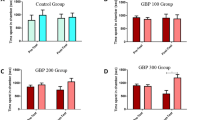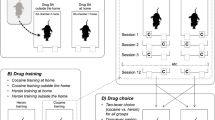Abstract
Rationale and objectives
Drug-seeking behavior occurs more readily in some individuals than others. This phenomenon is considered in studies of drug self-administration in which high drug-seeking/taking individuals can be identified. In contrast, studies of conditioned place preference (CPP) often involve a random sample of drug-naïve rodents that includes phenotypes not considered relevant to addiction. The main objective of the current studies was to determine if a priori identification of different conditioning phenotypes could improve the validity and sensitivity of CPP expression as a preclinical test for vulnerability to addiction.
Methods and results
Analysis of cocaine place conditioning data from 443 Swiss-Webster mice revealed a trimodal distribution with peaks corresponding to means of k = 3 clusters. The cluster means occurred at high, low, or negative preference scores, the latter suggesting a phenotype acquiring conditioned place aversion (CPA). The same clusters were identified in mice conditioned with methamphetamine, MDPV, or amphetamine, and these clusters remained stable and reliable during three additional expression tests spaced at 24 h. A meta-analysis of effect sizes obtained from CPP literature revealed a positively skewed distribution affected by sample size, consistent with the existence of a CPA phenotype within the populations tested. A dopamine receptor antagonist, flupentixol, blocked cocaine CPP expression in a group containing all phenotypes, but sensitivity improved markedly when CPA phenotypes were excluded from the dataset.
Conclusions
These studies suggest that taking phenotype into consideration when designing place conditioning studies will improve their application as a preclinical tool in addiction biology and drug discovery.






Similar content being viewed by others
References
Agrawal A, Lynskey MT (2008) Are there genetic influences on addiction: evidence from family, adoption and twin studies. Addiction (abingdon, England) 103:1069–1081
Bardo MT, Horton DB, Yates JR (2015) Chapter 7 - Conditioned Place Preference as a Preclinical Model for Screening Pharmacotherapies for Drug Abuse. In: Markgraf CG, Hudzik TJ, Compton DR (eds) Nonclinical Assessment of Abuse Potential for New Pharmaceuticals. Academic Press, Boston, pp 151–196
Becker JB (2016) Sex differences in addiction. Dialogues Clin Neurosci 18:395–402
Bozarth MA, Wise RA (1981) Intracranial self-administration of morphine into the ventral tegmental area in rats. Life Sci 28:551–555
Bozarth MA, Murray A, Wise RA (1989) Influence of housing conditions on the acquisition of intravenous heroin and cocaine self-administration in rats. Pharmacol Biochem Behav 33:903–907
Cohen J (1988) Statistical power analysis for the behavioral sciences. L. Erlbaum Associates, Hillsdale, N.J.
Costall B, Kelly ME, Naylor RJ, Onaivi ES (1989) The actions of nicotine and cocaine in a mouse model of anxiety. Pharmacol Biochem Behav 33:197–203
Davidson ES, Finch JF, Schenk S (1993) Variability in subjective responses to cocaine: initial experiences of college students. Addict Behav 18:445–453
de Wit H (2009) Impulsivity as a determinant and consequence of drug use: a review of underlying processes. Addict Biol 14:22–31
de Wit H, Phillips TJ (2012) Do initial responses to drugs predict future use or abuse? Neurosci Biobehav Rev 36:1565–1576
dela Cruz AM, Herin DV, Grady JJ, Cunningham KA (2009) Novel approach to data analysis in cocaine-conditioned place preference. Behav Pharmacol 20:720–730
Deneau G, Yanagita T, Seevers MH (1969) Self-administration of psychoactive substances by the monkey. Psychopharmacologia 16:30–48
DeVries AC, Pert A (1998) Conditioned increases in anxiogenic-like behavior following exposure to contextual stimuli associated with cocaine are mediated by corticotropin-releasing factor. Psychopharmacology 137:333–340
Egervari G, Ciccocioppo R, Jentsch JD, Hurd YL (2018) Shaping vulnerability to addiction—the contribution of behavior, neural circuits and molecular mechanisms. Neurosci Biobehav Rev 85:117–125
Flagel SB, Chaudhury S, Waselus M, Kelly R, Sewani S, Clinton SM, Thompson RC, Watson SJ Jr, Akil H (2016) Genetic background and epigenetic modifications in the core of the nucleus accumbens predict addiction-like behavior in a rat model. Proc Natl Acad Sci U S A 113:E2861–E2870
Gatch MB, Dolan SB, Forster MJ (2019) Locomotor activity and discriminative stimulus effects of five novel synthetic cathinone analogs in mice and rats. Drug Alcohol Depend 199:50–58
Gatch MB, Shetty RA, Sumien N, Forster MJ (2021) Behavioral effects of four novel synthetic cathinone analogs in rodents. Addict Biol 26:e12987
Kreek MJ, Bart G, Lilly C, LaForge KS, Nielsen DA (2005) Pharmacogenetics and human molecular genetics of opiate and cocaine addictions and their treatments. Pharmacol Rev 57:1–26
Le Q, Yan B, Yu X, Li Y, Song H, Zhu H, Hou W, Ma D, Wu F, Zhou Y, Ma L (2017) Drug-seeking motivation level in male rats determines offspring susceptibility or resistance to cocaine-seeking behaviour. Nat Commun 8:15527
Lynch WJ (2018) Modeling the development of drug addiction in male and female animals. Pharmacol Biochem Behav 164:50–61
Lynch WJ, Carroll ME (1999) Sex differences in the acquisition of intravenously self-administered cocaine and heroin in rats. Psychopharmacology 144:77–82
Mandt BH, Gomez E, Johnston NL, Zahniser NR, Allen RM (2012) Cocaine dose and self-administration history, but not initial cocaine locomotor responsiveness, affects sensitization to the motivational effects of cocaine in rats. J Pharmacol Exp Ther 342:214–221
Napier TC, Herrold AA, de Wit H (2013) Using conditioned place preference to identify relapse prevention medications. Neurosci Biobehav Rev 37:2081–2086
Piazza PV, Le Moal ML (1996) Pathophysiological basis of vulnerability to drug abuse: role of an interaction between stress, glucocorticoids, and dopaminergic neurons. Annu Rev Pharmacol Toxicol 36:359–378
Piazza PV, Deminiere JM, Le Moal M, Simon H (1989) Factors that predict individual vulnerability to amphetamine self-administration. Science 245:1511–1513
Piazza PV, Deroche-Gamonent V, Rouge-Pont F, Le Moal M (2000) Vertical shifts in self-administration dose-response functions predict a drug-vulnerable phenotype predisposed to addiction. J Neurosci 20:4226–4232
Pildervasser JV, Abrahao KP, Souza-Formigoni ML (2014) Distinct behavioral phenotypes in ethanol-induced place preference are associated with different extinction and reinstatement but not behavioral sensitization responses. Front Behav Neurosci 8:267
Rademacher DJ, Anders KA, Thompson KJ, Steinpreis RE (2000) The failure of some rats to acquire intravenous cocaine self-administration is attributable to conditioned place aversion. Behav Brain Res 117:13–19
Rohatgi A (November, 2020) WebPlotDigitizer
Sartor CE, Kranzler HR, Gelernter J (2014) Rate of progression from first use to dependence on cocaine or opioids: a cross-substance examination of associated demographic, psychiatric, and childhood risk factors. Addict Behav 39:473–479
Shetty RA, Rutledge MA, Forster MJ (2017) Retrograde conditioning of place preference and motor activity with cocaine in mice. Psychopharmacology 234:515–522
Tesone-Coelho C, Varela P, Escosteguy-Neto JC, Cavarsan CF, Mello LE, Santos-Junior JG (2013) Effects of ethanol on hippocampal neurogenesis depend on the conditioned appetitive response. Addict Biol 18:774–785
Wagner FA, Anthony JC (2007) Male-female differences in the risk of progression from first use to dependence upon cannabis, cocaine, and alcohol. Drug Alcohol Depend 86:191–198
White TL (2017) Beyond sensation seeking: a conceptual framework for individual differences in psychostimulant drug effects in healthy humans. Curr Opin Behav Sci 13:63–70
Funding
Support for this research was provided by contracts N01DA-7–8872 and N01DA-13–8908 from the National Institute on Drug Abuse. All locomotor activity data were generated under NIDA contracts. The CPP data were part of the development of protocols for cocaine-conditioned place preference for NIDA. NIDA had no further role in the design, analysis, or publication of this report.
Author information
Authors and Affiliations
Contributions
• Ritu A. Shetty — writing, conception and design, data acquisition, data analyses, literature search, plotting graphs.
• Margaret A. Rutledge — writing, design, data analyses (all data), and literature search
• Alison LeBouf — data collection and analyses (phenotype and reliability studies)
• James T. Mock — data interpretation and presentation (Fig. 1 and Fig. 2)
• Gita Pathak — data interpretation and presentation (Fig. 6)
• Michael J. Forster — writing, editing, conception, interpretation, data analyses
Corresponding author
Ethics declarations
Conflict of interest
The authors declare no competing interests.
Additional information
Publisher's note
Springer Nature remains neutral with regard to jurisdictional claims in published maps and institutional affiliations.
Supplementary Information
Below is the link to the electronic supplementary material.
Supplementary file2
(XLS 205 KB)
Supplementary file3
(XLSX 279 KB)
Supplementary file4
(XLS 281 KB)
Supplementary file5
(XLS 96.0 KB)
Supplementary file6
(XLS 272 KB)
Rights and permissions
About this article
Cite this article
Shetty, R.A., Rutledge, M., LeBouf, A. et al. Expression of stable and reliable preference and aversion phenotypes following place conditioning with psychostimulants. Psychopharmacology 239, 2593–2603 (2022). https://doi.org/10.1007/s00213-022-06130-8
Received:
Accepted:
Published:
Issue Date:
DOI: https://doi.org/10.1007/s00213-022-06130-8




